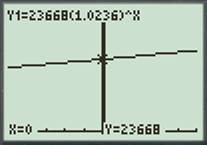
Concept explainers
(a)
To find: The exponential regression for the given data and also graph it.
(a)
Answer to Problem 40E
The exponential regression is
Explanation of Solution
Given information:
The following table gives the population of Texas for several years:
| Population of Texas | |
| Year | Population (thousands) |
Calculation:
Assume that the exponential regression for population is
As
Substitute
Now, the year
Use the calculator for the value of
So, the value of
To graph a function
First press “ON” button on graphical calculator, press
The display will show the equation,
Now, press the

Figure (1)
Therefore, the exponential regression is
(b)
To find: The population of Texas in
(b)
Answer to Problem 40E
The population of Texas in
Explanation of Solution
Given information:
The following table gives the population of Texas for several years:
| Population of Texas | |
| Year | Population (thousands) |
Calculation:
As calculated in part (a), the exponential regression for population is
The population in
Use the calculator for the value of
So, the population of Texas in year
Therefore, the population of Texas in
(c)
To find: The annual rate of growth of population of Texas.
(c)
Answer to Problem 40E
The population increase by
Explanation of Solution
Given information:
The following table gives the population of Texas for several years:
| Population of Texas | |
| Year | Population (thousands) |
Calculation:
As calculated in part (a), the exponential regression for population is
By the exponential regression tells that the population of Texas becomes
So, the rate of growth of the population is
Therefore, the population increases by
Chapter 1 Solutions
Calculus 2012 Student Edition (by Finney/Demana/Waits/Kennedy)
Additional Math Textbook Solutions
Precalculus Enhanced with Graphing Utilities (7th Edition)
Calculus: Early Transcendentals (2nd Edition)
Calculus and Its Applications (11th Edition)
Calculus: Early Transcendentals (3rd Edition)
Calculus, Single Variable: Early Transcendentals (3rd Edition)
 Calculus: Early TranscendentalsCalculusISBN:9781285741550Author:James StewartPublisher:Cengage Learning
Calculus: Early TranscendentalsCalculusISBN:9781285741550Author:James StewartPublisher:Cengage Learning Thomas' Calculus (14th Edition)CalculusISBN:9780134438986Author:Joel R. Hass, Christopher E. Heil, Maurice D. WeirPublisher:PEARSON
Thomas' Calculus (14th Edition)CalculusISBN:9780134438986Author:Joel R. Hass, Christopher E. Heil, Maurice D. WeirPublisher:PEARSON Calculus: Early Transcendentals (3rd Edition)CalculusISBN:9780134763644Author:William L. Briggs, Lyle Cochran, Bernard Gillett, Eric SchulzPublisher:PEARSON
Calculus: Early Transcendentals (3rd Edition)CalculusISBN:9780134763644Author:William L. Briggs, Lyle Cochran, Bernard Gillett, Eric SchulzPublisher:PEARSON Calculus: Early TranscendentalsCalculusISBN:9781319050740Author:Jon Rogawski, Colin Adams, Robert FranzosaPublisher:W. H. Freeman
Calculus: Early TranscendentalsCalculusISBN:9781319050740Author:Jon Rogawski, Colin Adams, Robert FranzosaPublisher:W. H. Freeman
 Calculus: Early Transcendental FunctionsCalculusISBN:9781337552516Author:Ron Larson, Bruce H. EdwardsPublisher:Cengage Learning
Calculus: Early Transcendental FunctionsCalculusISBN:9781337552516Author:Ron Larson, Bruce H. EdwardsPublisher:Cengage Learning





